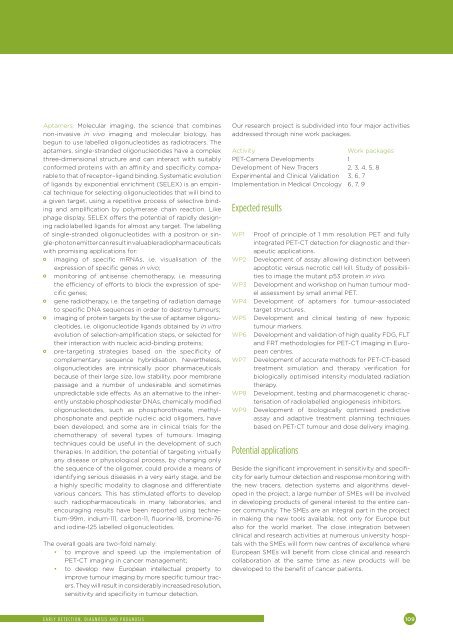Create successful ePaper yourself
Turn your PDF publications into a flip-book with our unique Google optimized e-Paper software.
Aptamers. Molecular imaging, the science that combines<br />
non-invasive in vivo imaging and molecular biology, has<br />
begun to use labelled oligonucleotides as radiotracers. The<br />
aptamers, single-stranded oligonucleotides have a complex<br />
three-dimensional structure and can interact with suitably<br />
conformed proteins with an affi nity and specifi city comparable<br />
to that of receptor–ligand binding. Systematic evolution<br />
of ligands by exponential enrichment (SELEX) is an empirical<br />
technique for selecting oligonucleotides that will bind to<br />
a given target, using a repetitive process of selective binding<br />
and amplifi cation by polymerase chain reaction. Like<br />
phage display, SELEX off ers the potential of rapidly designing<br />
radiolabelled ligands for almost any target. The labelling<br />
of single-stranded oligonucleotides with a positron or single-photon<br />
emitter can result in valuable radiopharmaceuticals<br />
with promising applications for:<br />
• imaging of specifi c mRNAs, i.e. visualisation of the<br />
expression of specifi c genes in vivo;<br />
• monitoring of antisense chemotherapy, i.e. measuring<br />
the effi ciency of eff orts to block the expression of specifi<br />
c genes;<br />
• gene radiotherapy, i.e. the targeting of radiation damage<br />
to specifi c DNA sequences in order to destroy tumours;<br />
• imaging of protein targets by the use of aptamer oligonucleotides,<br />
i.e. oligonucleotide ligands obtained by in vitro<br />
evolution of selection-amplifi cation steps, or selected for<br />
their interaction with nucleic acid-binding proteins;<br />
• pre-targeting strategies based on the specifi city of<br />
complementary sequence hybridisation. Nevertheless,<br />
oligonucleotides are intrinsically poor pharmaceuticals<br />
because of their large size, low stability, poor membrane<br />
passage and a number of undesirable and sometimes<br />
unpredictable side eff ects. As an alternative to the inherently<br />
unstable phosphodiester DNAs, chemically modifi ed<br />
oligonucleotides, such as phosphorothioate, methylphosphonate<br />
and peptide nucleic acid oligomers, have<br />
been developed, and some are in clinical trials for the<br />
chemotherapy of several types of tumours. Imaging<br />
techniques could be useful in the development of such<br />
therapies. In addition, the potential of targeting virtually<br />
any disease or physiological process, by changing only<br />
the sequence of the oligomer, could provide a means of<br />
identifying serious diseases in a very early stage, and be<br />
a highly specifi c modality to diagnose and diff erentiate<br />
various cancers. This has stimulated eff orts to develop<br />
such radiopharmaceuticals in many laboratories, and<br />
encouraging results have been reported using technetium-99m,<br />
indium-111, carbon-11, fl uorine-18, bromine-76<br />
and iodine-125 labelled oligonucleotides.<br />
The overall goals are two-fold namely:<br />
• to improve and speed up the implementation of<br />
PET-CT imaging in cancer management;<br />
• to develop new European intellectual property to<br />
improve tumour imaging by more specifi c tumour tracers.<br />
They will result in considerably increased resolution,<br />
sensitivity and specifi city in tumour detection.<br />
EARLY DETECTION, DIAGNOSIS AND PROGNOSIS<br />
Our research project is subdivided into four major activities<br />
addressed through nine work packages.<br />
Activity Work packages<br />
PET-Camera Developments 1<br />
Development of New Tracers 2, 3, 4, 5, 8<br />
Experimental and Clinical Validation 3, 6, 7<br />
Implementation in Medical Oncology 6, 7, 9<br />
Expected results<br />
WP1 Proof of principle of 1 mm resolution PET and fully<br />
integrated PET-CT detection for diagnostic and therapeutic<br />
applications.<br />
WP2 Development of assay allowing distinction between<br />
apoptotic versus necrotic cell kill. Study of possibilities<br />
to image the mutant p53 protein in vivo.<br />
WP3 Development and workshop on human tumour model<br />
assessment by small animal PET.<br />
WP4 Development of aptamers for tumour-associated<br />
target structures.<br />
WP5 Development and clinical testing of new hypoxic<br />
tumour markers.<br />
WP6 Development and validation of high quality FDG, FLT<br />
and FRT methodologies for PET-CT imaging in European<br />
centres.<br />
WP7 Development of accurate methods for PET-CT-based<br />
treatment simulation and therapy verifi cation for<br />
biologically optimised intensity modulated radiation<br />
therapy.<br />
WP8 Development, testing and pharmacogenetic characterisation<br />
of radiolabelled angiogenesis inhibitors.<br />
WP9 Development of biologically optimised predictive<br />
assay and adaptive treatment planning techniques<br />
based on PET-CT tumour and dose delivery imaging.<br />
Potential applications<br />
Beside the signifi cant improvement in sensitivity and specifi -<br />
city for early tumour detection and response monitoring with<br />
the new tracers, detection systems and algorithms developed<br />
in the project, a large number of SMEs will be involved<br />
in developing products of general interest to the entire cancer<br />
community. The SMEs are an integral part in the project<br />
in making the new tools available, not only for Europe but<br />
also for the world market. The close integration between<br />
clinical and research activities at numerous university hospitals<br />
with the SMEs will form new centres of excellence where<br />
European SMEs will benefi t from close clinical and research<br />
collaboration at the same time as new products will be<br />
developed to the benefi t of cancer patients.<br />
109
















